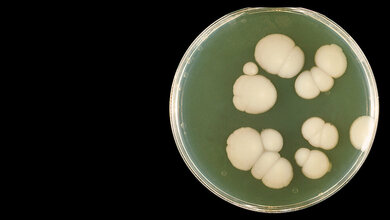Zusammenfassung
In der Medizin gehören die häufigsten und wichtigsten Sprosspilze zu den Askomyzeten. In diese Gruppe gehören Candida spp. (zum Beispiel Candida albicans, Candida glabrata, Candida krusei und noch >200 Arten), Saccharomyces spp. (Bierhefe, Bäckerhefe) und Geotrichum spp. („Milchschimmel“). Sie sind in der Natur weit verbreitet und besiedeln auch gelegentlich die Haut, Schleimhäute, Darm und Urin des Menschen ohne eine Infektion zu erzeugen. Da aber einige Vertreter aufgrund von einigen Virulenzfaktoren potenziell pathogen sind, warten diese Opportunisten auf eine günstige Gelegenheit, in den Körper einzudringen und eine entzündliche Reaktion hervorzurufen. Sie bilden meistens einen Biofilm und sind so gegen die meisten Antimykotika unempfindlich.
Schlüsselwörter: askomyzetische Sprosspilze, Candida spp., Saccharomyces spp., Geotrichum spp.
Abstract
The most frequent and important yeasts in medicine are found in the group of ascomycetes, namely Candida spp. (i.e. Candida albicans, Candida glabrata, Candida krusei and > 200 other species), Saccharomyces spp. (brewer’s yeast, baker’s yeast) and Geotrichum spp.. They are widespread in nature and occasionally they colonize the skin, mucosal surfaces, gut and urine of humans without an ensuing infection. Since at least some of them express virulence factors, they are potential pathogens. Hence, these opportunistic fungi are waiting for favorable conditions to penetrate into the human body and trigger inflammatory reactions in practically all organs. If they grow on plastic catheters, they often built biofilms, where they loose susceptibility to most antimycotics.
Keywords: ascomycetes, Candida spp., Saccharomyces spp., Geotrichum spp.
DOI: 10.3238/MTADIALOG.2019.0974
Entnommen aus MTA Dialog 11/2019
Dann nutzen Sie jetzt unser Probe-Abonnement mit 3 Ausgaben zum Kennenlernpreis von € 19,90.
Jetzt Abonnent werden


